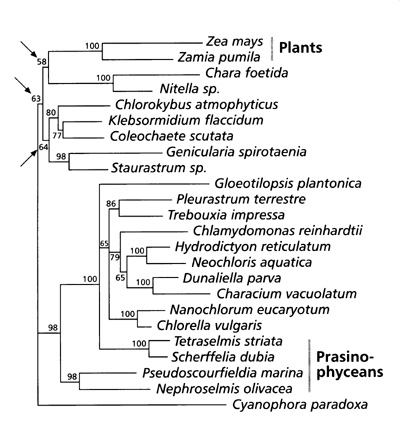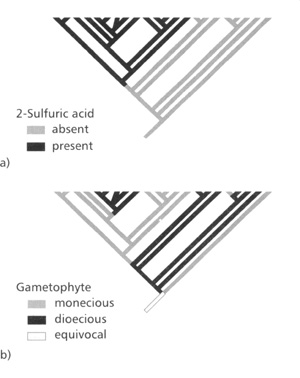|
Navigation
BOT4404
Main Page
FIU
Home
FIU
Marine Biology Home
Dept.
Biology Home
Frank
Jochem Home
E-Mail
|
Taxonomy
and Sytematics of Algae
-
Depending
on methodology and philosophy, there are between 50,000 and 10 million
different algal species
-
Algal
taxonomy and systematics is under constant discussion and change, even
more after introduction of molecular techniques
-
The history
of algal classification went from morphology to ultrastructure to genomic
analyes; sometimes genetic and morphological classifications contradict
-
Sometimes
morphology can mislead when one species exhibits several „growth forms“,
dependent on envrionmental conditions:
The Biological
Concept of „Species“
-
Classical
definition: If two individuals can produce
viable offspring, they belong to one species.
-
Problems:
Sexual reproduction is not observed in some algal groups and occurs rarely
in others; culture material may not be available or environmental conditions
to induce sexual reproduction are unknown
-
Hybrids:
intergenetic as well as fertile hybrids from morphologically distinct species
occur in algae, particularily in kelp
-
Morphological
species concept: one species can exhibit different
growth forms, physiological attributes may differ among morphologically
identical isolates
-
Phylogenetic
species concept: address the genetic similarity
among specimens; also provide evolutionary information. Ideally, a species
should be monophyletic, i.e. have one common ancestor. Some species, however,
appear paraphyletic (groups of analyzed strains do not include all of the
descendants of a commong ancestor)
Molecular Sequences
versus Morphology
-
Morphologically
deduced phylogeny can be misleading due to
parallel or convergent evolution (e.g. squid and human eyes)
-
Molecular
sequeces can also undergo parallel and convergent
evolution; it is not possible to conclude that molecular phylogenies represent
the „ultimate truth“
-
Sole
reliance upon molecular data excludes important
data
-
Modern
approaches check molecular phylogeny against
morpholo-gical phylogenies, or two molecular phylogenies based on different
genetic information (SSU rRNA vs plastid DNA) for congruence
-
Addressed
sequences: Ribosomal RNA, protein-coding genes,
internal spacer regions (ITS, nuclear-encoded ribosomal RNA), DNA fingerprinting
(randomly amplified polymorphic DNA, restriction fragment-length polymorphism),
microsatellite DNA, presence and location of introns
Phylogenetic
Trees
-
The tree:
Statistical analyses (computer-based) produce dichotomous trees and group
similar species in close clusters; the length of the branches indicates
the genetic similarity (kinship) between branches
-
Bootstrep
values indicate how solid a certain branch
is supported by the data; value should be >50, max 100

Application
of Phylogeny
-
Revisit
species concept: molecular phylogenetic studies
showed that zooxanthellae in corals are more genetically diverse than thought;
evidence that prochlorophytes (Prochlorococcus), the smallest phytoplankton
(0.4 µm), are not a coherent cluster but strains are often closer
related to coccoid cyanobacteria than to other prochlorophyte strains
-
Evolutionary
utility: assess monophyletic or polyphyletic
origin of algal groups or algal characteristics

-
Ecologically
utility: diversity of plankton communities;
prove of N2-fixation by the filamentous cyanobacterium Trichodesmium
because its nifH gene is different from those of bacteria; which
organisms are capable of which physiological processes (presence/ absence
of the necessary gene)
|

